Effects of Warming and Precipitation on Soil CO2 Flux and Its Stable Carbon Isotope Composition in the Temperate Desert Steppe
Abstract
:1. Introduction
2. Materials and Methods
2.1. Study Area
2.2. Experiment Design
2.3. Measurements of CO2 and Soil Parameters
2.4. Isotopic Signature of Soil CO2 Efflux Analysis and Calculation
2.5. Statistical Analyses
3. Results
3.1. Effects of Warming and Precipitation on Soil Temperature and Moisture
3.2. Effects of Warming and Precipitation on Soil CO2 Flux and Its Isotope Characteristics
3.3. Effects of Warming and Precipitation on SOC and Its δ13C Values
3.4. Key Factors Affecting Soil CO2 Efflux and Its δ13C Values
3.5. The Difference between δ13C Values of Soil CO2 Efflux and SOC
4. Discussion
4.1. Effect of Warming and Precipitation on Soil CO2 Efflux
4.2. Effect of Warming and Precipitation on δ13C Values of CO2 Efflux
4.3. The Difference between δ13CO2e and δ13Csoil
5. Conclusions
Author Contributions
Funding
Institutional Review Board Statement
Informed Consent Statement
Data Availability Statement
Acknowledgments
Conflicts of Interest
References
- Lyon, C.; Saupe, E.E.; Smith, C.J.; Hill, D.J.; Beckerman, A.P.; Stringer, L.C.; Marchant, R.; McKay, J.; Burke, A.; O’Higgins, P.; et al. Climate change research and action must look beyond 2100. Glob. Chang. Biol. 2022, 28, 349–361. [Google Scholar] [CrossRef] [PubMed]
- Yu, C.Q.; Wang, J.W.; Shen, Z.X.; Fu, G. Effects of experimental warming and increased precipitation on soil respiration in an alpine meadow in the Northern Tibetan Plateau. Sci. Total Environ. 2019, 647, 1490–1497. [Google Scholar] [CrossRef] [PubMed]
- Arunrat, N.; Sereenonchai, S.; Wang, C. Carbon footprint and predicting the impact of climate change on carbon sequestration ecosystem services of organic rice farming and conventional rice farming: A case study in Phichit province, Thailand. J. Environ. Manag. 2021, 289, 112458. [Google Scholar] [CrossRef] [PubMed]
- Millard, P.; Midwood, A.J.; Hunt, J.E.; Whitehead, D.; Boutton, T.W. Partitioning soil surface CO2 efflux into autotrophic and heterotrophic components, using natural gradients in soil δ13C in an undisturbed savannah soil. Soil Biol. Biochem. 2008, 40, 1575–1582. [Google Scholar] [CrossRef]
- Zhou, J.; Yang, Z.; Wu, G.; Yang, Y.; Lin, G. The relationship between soil CO2 efflux and its carbon isotopic composition under non-steady-state conditions. Agric. For. Meteorol. 2018, 256–257, 492–500. [Google Scholar] [CrossRef]
- Millard, P.; Sommerkorn, M.; Grelet, G.A. Environmental change and carbon limitation in trees: A biochemical, ecophysiological and ecosystem appraisal. New Phytol. 2007, 175, 11–28. [Google Scholar] [CrossRef] [PubMed]
- Lai, L.; Wang, J.; Tian, Y.; Zhao, X.; Jiang, L.; Chen, X.; Gao, Y.; Wang, S.; Zheng, Y. Organic Matter and Water Addition Enhance Soil Respiration in an Arid Region. PLoS ONE 2013, 8, e77659. [Google Scholar] [CrossRef] [PubMed] [Green Version]
- Ravn, N.R.; Elberling, B.; Michelsen, A. Arctic soil carbon turnover controlled by experimental snow addition, summer warming and shrub removal. Soil Biol. Biochem. 2020, 142, 107698. [Google Scholar] [CrossRef]
- Balogh, J.; Papp, M.; Pintér, K.; Fóti, S.; Posta, K.; Eugster, W.; Nagy, Z. Autotrophic component of soil respiration is repressed by drought more than the heterotrophic one in dry grasslands. Biogeosciences 2016, 13, 5171–5182. [Google Scholar] [CrossRef] [Green Version]
- Harper, C.W.; Blair, J.M.; Fay, P.A.; Knapp, A.K.; Carlisle, J.D. Increased rainfall variability and reduced rainfall amount decreases soil CO2 flux in a grassland ecosystem. Glob. Chang. Biol. 2005, 11, 322–334. [Google Scholar] [CrossRef]
- Wu, G.; Chen, X.M.; Ling, J.; Li, F.; Li, F.Y.; Peixoto, L.; Wen, Y.; Zhou, S.L. Effects of soil warming and increased precipitation on greenhouse gas fluxes in spring maize seasons in the North China Plain. Sci. Total Environ. 2020, 734, 139269. [Google Scholar] [CrossRef] [PubMed]
- Vanhala, P.; Karhu, K.; Tuomi, M.; Sonninen, E.; Jungner, H.; Fritze, H.; Liski, J. Old soil carbon is more temperature sensitive than the young in an agricultural field. Soil Biol. Biochem. 2007, 39, 2967–2970. [Google Scholar] [CrossRef]
- Midwood, A.J.; Gebbing, T.; Wendler, R.; Sommerkorn, M.; Hunt, J.E.; Millard, P. Collection and storage of CO2 for 13C analysis: An application to separate soil CO2 efflux into root- and soil-derived components. Rapid Commun. Mass Spectrom. 2006, 20, 3379–3384. [Google Scholar] [CrossRef] [PubMed]
- Bowling, D.R.; Egan, J.E.; Hall, S.J.; Risk, D.A. Environmental forcing does not induce diel or synoptic variation in the carbon isotope content of forest soil respiration. Biogeosciences 2015, 12, 5143–5160. [Google Scholar] [CrossRef] [Green Version]
- Gamnitzer, U.; Moyes, A.B.; Bowling, D.R.; Schnyder, H. Measuring and modelling the isotopic composition of soil respiration: Insights from a grassland tracer experiment. Biogeosciences 2011, 8, 1333–1350. [Google Scholar] [CrossRef] [Green Version]
- Volk, M.; Bassin, S.; Lehmann, M.F.; Johnson, M.G.; Andersen, C.P. 13C isotopic signature and C concentration of soil density fractions illustrate reduced C allocation to subalpine grassland soil under high atmospheric N deposition. Soil Biol. Biochem. 2018, 125, 178–184. [Google Scholar] [CrossRef] [PubMed]
- Jacotot, A.; Marchand, C.; Allenbach, M. Biofilm and temperature controls on greenhouse gas (CO2 and CH4) emissions from a Rhizophora mangrove soil (New Caledonia). Sci. Total Environ. 2019, 650, 1019–1028. [Google Scholar] [CrossRef] [PubMed]
- Talmon, Y.; Sternberg, M.; Grünzweig, J.M. Impact of rainfall manipulations and biotic controls on soil respiration in Mediterranean and desert ecosystems along an aridity gradient. Glob. Chang. Biol. 2011, 17, 1108–1118. [Google Scholar] [CrossRef]
- Midwood, A.J.; Millard, P. Challenges in measuring the δ13C of the soil surface CO2 efflux. Rapid Commun. Mass Spectrom. 2011, 25, 232–242. [Google Scholar] [CrossRef] [PubMed]
- Biasi, C.; Rusalimova, O.; Meyer, H.; Kaiser, C.; Wanek, W.; Barsukov, P.; Junger, H.; Richter, A. Temperature-dependent shift from labile to recalcitrant carbon sources of arctic heterotrophs. Rapid Commun. Mass Spectrom. 2005, 19, 1401–1408. [Google Scholar] [CrossRef] [PubMed]
- Phillips, C.L.; Nickerson, N.; Risk, D.; Kayler, Z.E.; Andersen, C.; Mix, A.; Bond, B.J. Soil moisture effects on the carbon isotope composition of soil respiration. Rapid Commun. Mass Spectrom. 2010, 24, 1271–1280. [Google Scholar] [CrossRef] [PubMed]
- Qin, Y.; Yi, S.; Chen, J.; Ren, S.; Wang, X. Responses of ecosystem respiration to short-term experimental warming in the alpine meadow ecosystem of a permafrost site on the Qinghai-Tibetan Plateau. Cold Reg. Sci. Technol. 2015, 115, 77–84. [Google Scholar] [CrossRef]
- Buchmann, N.; Kao, W.Y.; Ehleringer, J. Influence of stand structure on carbon-13 of vegetation, soils, and canopy air within deciduous and evergreen forests in Utah, United States. Oecologia 1997, 110, 109–119. [Google Scholar] [CrossRef] [PubMed]
- Bowling, D.R.; McDowell, N.G.; Bond, B.J.; Law, B.E.; Ehleringer, J.R. 13C content of ecosystem respiration is linked to precipitation and vapor pressure deficit. Oecologia 2002, 131, 113–124. [Google Scholar] [CrossRef] [PubMed]
- Butcher, K.R.; Nasto, M.K.; Norton, J.M.; Stark, J.M. Physical mechanisms for soil moisture effects on microbial carbon-use efficiency in a sandy loam soil in the western United States. Soil Biol. Biochem. 2020, 150, 107969. [Google Scholar] [CrossRef]
- Keeling, C.D. The concentration and isotopic abundances of carbon dioxide in rural and marine air. Geochim. Cosmochim. Acta 1961, 24, 277–298. [Google Scholar] [CrossRef]
- Lv, G.; Wang, Z.; Guo, N.; Xu, X.; Liu, P.; Wang, C. Status of Stipa breviflora as the constructive species will be lost under climate change in the temperate desert steppe in the future. Ecol. Indic. 2021, 126, 107715. [Google Scholar] [CrossRef]
- Brüggemann, N.; Gessler, A.; Kayler, Z.; Keel, S.G.; Badeck, F.; Barthel, M.; Boeckx, P.; Buchmann, N.; Brugnoli, E.; Esperschütz, J.; et al. Carbon allocation and carbon isotope fluxes in the plant-soil-atmosphere continuum: A review. Biogeosciences 2011, 8, 3457–3489. [Google Scholar] [CrossRef] [Green Version]
- Bahn, M.; Schmitt, M.; Siegwolf, R.; Richter, A.; Brüggemann, N. Does photosynthesis affect grassland soil-respired CO2 and its carbon isotope composition on a diurnal timescale? New Phytol. 2009, 182, 451–460. [Google Scholar] [CrossRef] [PubMed] [Green Version]
- Tang, S.; Zhang, Y.; Guo, Y.; Zhai, X.; Wilkes, A.; Han, G.; Jiang, Y.; Liu, K.; Zhou, P.; Wang, K.; et al. Changes of soil CO2 flux under different stocking rates during spring-thaw period in a northern desert steppe, China. Atmos. Environ. 2015, 122, 343–348. [Google Scholar] [CrossRef]
- Wang, C.J.; Tang, S.M.; Wilkes, A.; Jiang, Y.Y.; Han, G.D.; Huang, D. Effect of stocking rate on soil-atmosphere CH4 flux during spring freeze-thaw cycles in a Northern desert steppe, China. PLoS ONE 2012, 7, e36794. [Google Scholar] [CrossRef]
- Ollivier, Q.R.; Maher, D.T.; Pitfield, C.; Macreadie, P.I. Winter emissions of CO2, CH4, and N2O from temperate agricultural dams: Fluxes, sources, and processes. Ecosphere 2019, 10, e02914. [Google Scholar] [CrossRef] [Green Version]
- Luo, C.; Wang, S.; Zhang, L.; Wilkes, A.; Zhao, L.; Zhao, X.; Xu, S.; Xu, B. CO2, CH4 and N2O fluxes in an alpine meadow on the Tibetan Plateau as affected by N-addition and grazing exclusion. Nutr. Cycl. Agroecosystems 2020, 117, 29–42. [Google Scholar] [CrossRef] [Green Version]
- Zhou, Y.; Ding, Y.; Li, H.; Xu, X.; Li, Y.; Zhang, W.; Lin, H. The effects of short-term grazing on plant and soil carbon and nitrogen isotope composition in a temperate grassland. J. Arid Environ. 2020, 179, 104198. [Google Scholar] [CrossRef]
- Lin, G.; Rygiewicz, P.T.; Ehleringer, J.R.; Johnson, M.G.; Tingey, D.T. Time-dependent responses of soil CO2 efflux components to elevated atmospheric [CO2] and temperature in experimental forest mesocosms. Plant Soil 2001, 229, 259–270. [Google Scholar] [CrossRef]
- Pataki, D.E.; Ehleringer, J.R.; Flanagan, L.B.; Yakir, D.; Bowling, D.R.; Still, C.J.; Buchmann, N.; Kaplan, J.O.; Berry, J.A. The application and interpretation of Keeling plots in terrestrial carbon cycle research. Global Biogeochem. Cycles 2003, 17, 1022. [Google Scholar] [CrossRef] [Green Version]
- Deng, Q.; Hui, D.; Zhang, D.; Zhou, G.; Liu, J.; Liu, S.; Chu, G.; Li, J. Effects of precipitation increase on soil respiration: A three-year field experiment in subtropical forests in China. PLoS ONE 2012, 7, e41493. [Google Scholar] [CrossRef]
- Wang, G.; Jia, Y.; Li, W. Effects of environmental and biotic factors on carbon isotopic fractionation during decomposition of soil organic matter. Sci. Rep. 2015, 5, 11043. [Google Scholar] [CrossRef] [PubMed] [Green Version]
- Na, L.; Genxu, W.; Yan, Y.; Yongheng, G.; Guangsheng, L. Plant production, and carbon and nitrogen source pools, are strongly intensified by experimental warming in alpine ecosystems in the Qinghai-Tibet Plateau. Soil Biol. Biochem. 2011, 43, 942–953. [Google Scholar] [CrossRef]
- Zhang, Q.; Wu, J.; Lei, Y.; Yang, F.; Zhang, D.; Zhang, K.; Zhang, Q.; Cheng, X. Agricultural land use change impacts soil CO2 emission and its 13C-isotopic signature in central China. Soil Tillage Res. 2018, 177, 105–112. [Google Scholar] [CrossRef]
- Pedersen, E.P.; Elberling, B.; Michelsen, A. Seasonal variations in methane fluxes in response to summer warming and leaf litter addition in a subarctic heath ecosystem. J. Geophys. Res. Biogeosciences 2017, 122, 2137–2153. [Google Scholar] [CrossRef]
- Zhao, K.; Kong, W.; Wang, F.; Long, X.E.; Guo, C.; Yue, L.; Yao, H.; Dong, X. Desert and steppe soils exhibit lower autotrophic microbial abundance but higher atmospheric CO2 fixation capacity than meadow soils. Soil Biol. Biochem. 2018, 127, 230–238. [Google Scholar] [CrossRef]
- Ravn, N.R.; Ambus, P.; Michelsen, A. Impact of decade-long warming, nutrient addition and shading on emission and carbon isotopic composition of CO2 from two subarctic dwarf shrub heaths. Soil Biol. Biochem. 2017, 111, 15–24. [Google Scholar] [CrossRef]
- Quan, Q.; Tian, D.; Luo, Y.; Zhang, F.; Crowther, T.W.; Zhu, K.; Chen, H.Y.H.; Zhou, Q.; Niu, S. Water scaling of ecosystem carbon cycle feedback to climate warming. Sci. Adv. 2019, 5, 1–8. [Google Scholar] [CrossRef] [PubMed] [Green Version]
- Borowik, A.; Wyszkowska, J. Soil moisture as a factor affecting the microbiological and biochemical activity of soil. Plant Soil Environ. 2016, 62, 250–255. [Google Scholar] [CrossRef]
- Tate, R.L.; Terry, R.E. Variation in Microbial Activity in Histosols and Its Relationship to Soil Moisture. Appl. Environ. Microbiol. 1980, 40, 313–317. [Google Scholar] [CrossRef] [PubMed] [Green Version]
- Liang, L.L.; Riveros-Iregui, D.A.; Risk, D.A. Spatial and seasonal variabilities of the stable carbon isotope composition of soil CO2 concentration and flux in complex terrain. J. Geophys. Res. Biogeosci. 2016, 121, 2328–2339. [Google Scholar] [CrossRef]
- Dorrepaal, E.; Toet, S.; Van Logtestijn, R.S.P.; Swart, E.; Van De Weg, M.J.; Callaghan, T.V.; Aerts, R. Carbon respiration from subsurface peat accelerated by climate warming in the subarctic. Nature 2009, 460, 616–619. [Google Scholar] [CrossRef]
- Andrews, J.A.; Matamala, R.; Westover, K.M.; Schlesinger, W.H. Temperature effects on the diversity of soil heterotrophs and the δ13C of soil-respired CO2. Soil Biol. Biochem. 2000, 32, 699–706. [Google Scholar] [CrossRef]
- Huang, W.; Hall, S.J. Large impacts of small methane fluxes on carbon isotope values of soil respiration. Soil Biol. Biochem. 2018, 124, 126–133. [Google Scholar] [CrossRef] [Green Version]
- Ehleringer, J.R.; Buchmann, N.; Flanagan, L.B. Carbon isotope ratios in belowground carbon cycle processes. Ecol. Appl. 2000, 10, 412–422. [Google Scholar] [CrossRef]
- Flanagan, L.B.; Ehleringer, J.R. Ecosystem-atmosphere CO2 exchange: Interpreting signals of change using stable isotope ratios. Trends Ecol. Evol. 1998, 13, 10–14. [Google Scholar] [CrossRef]
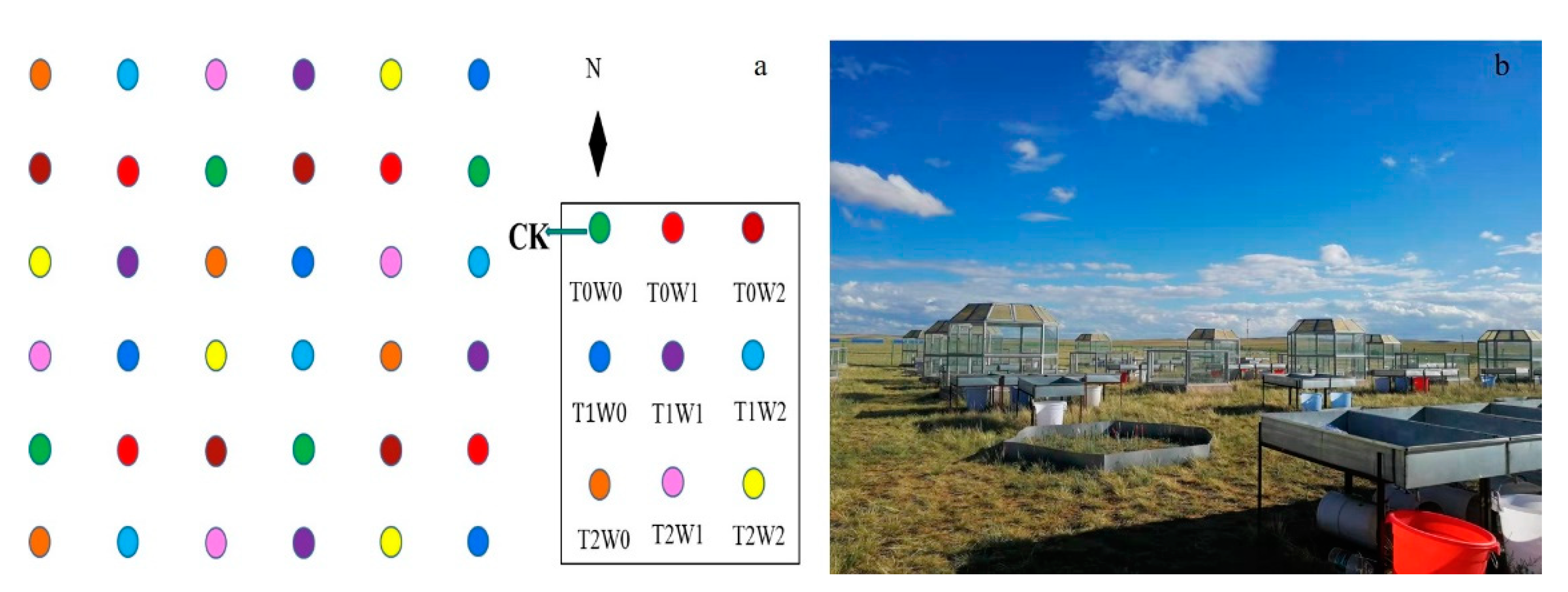

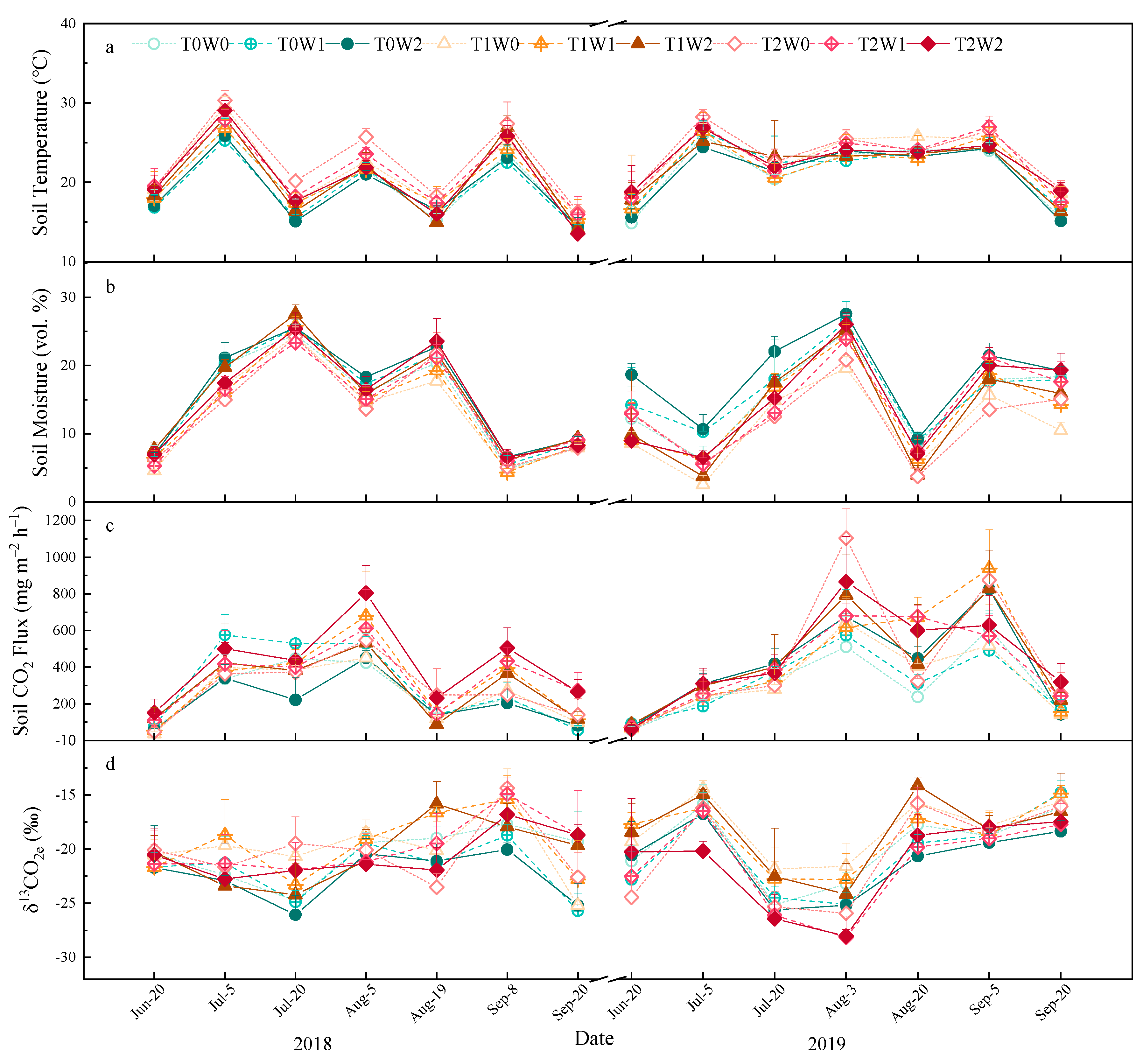

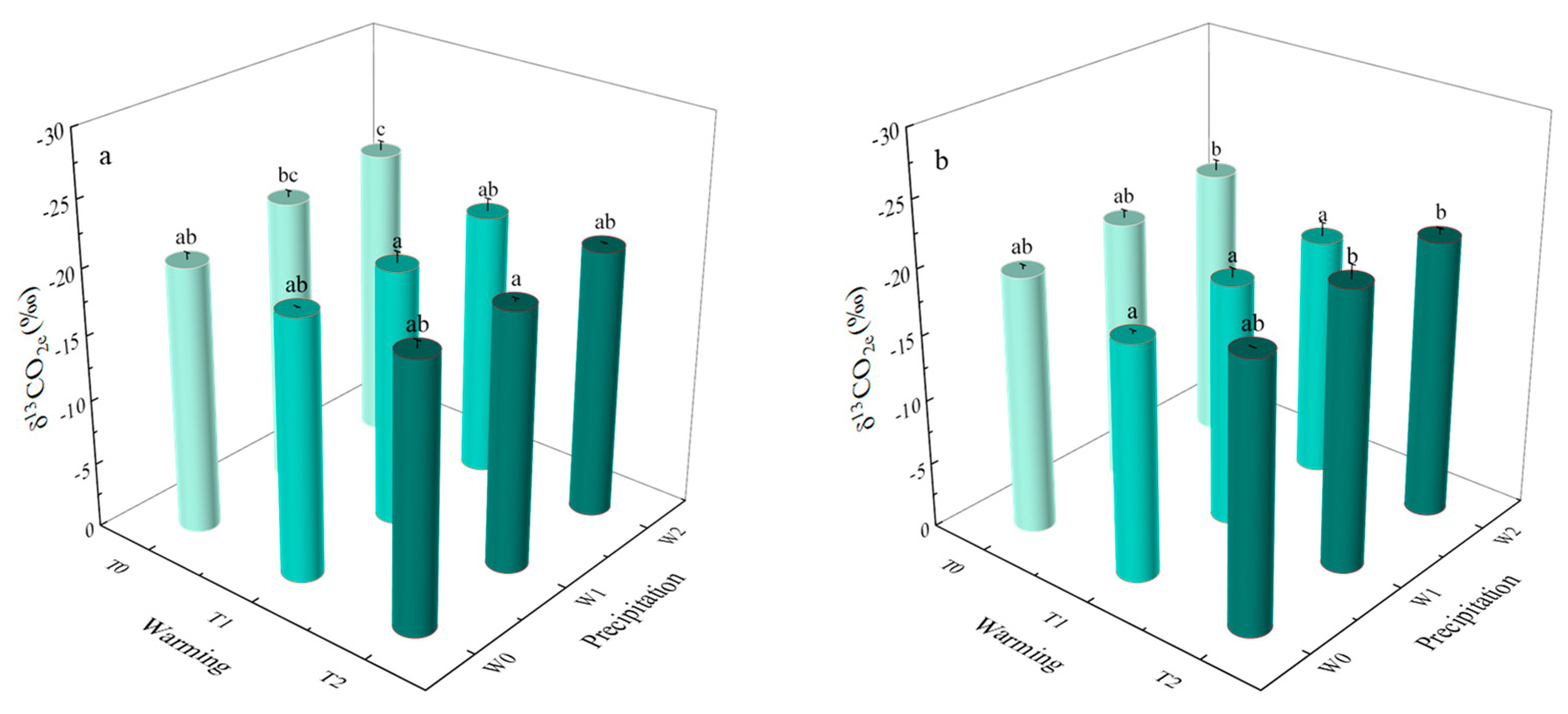
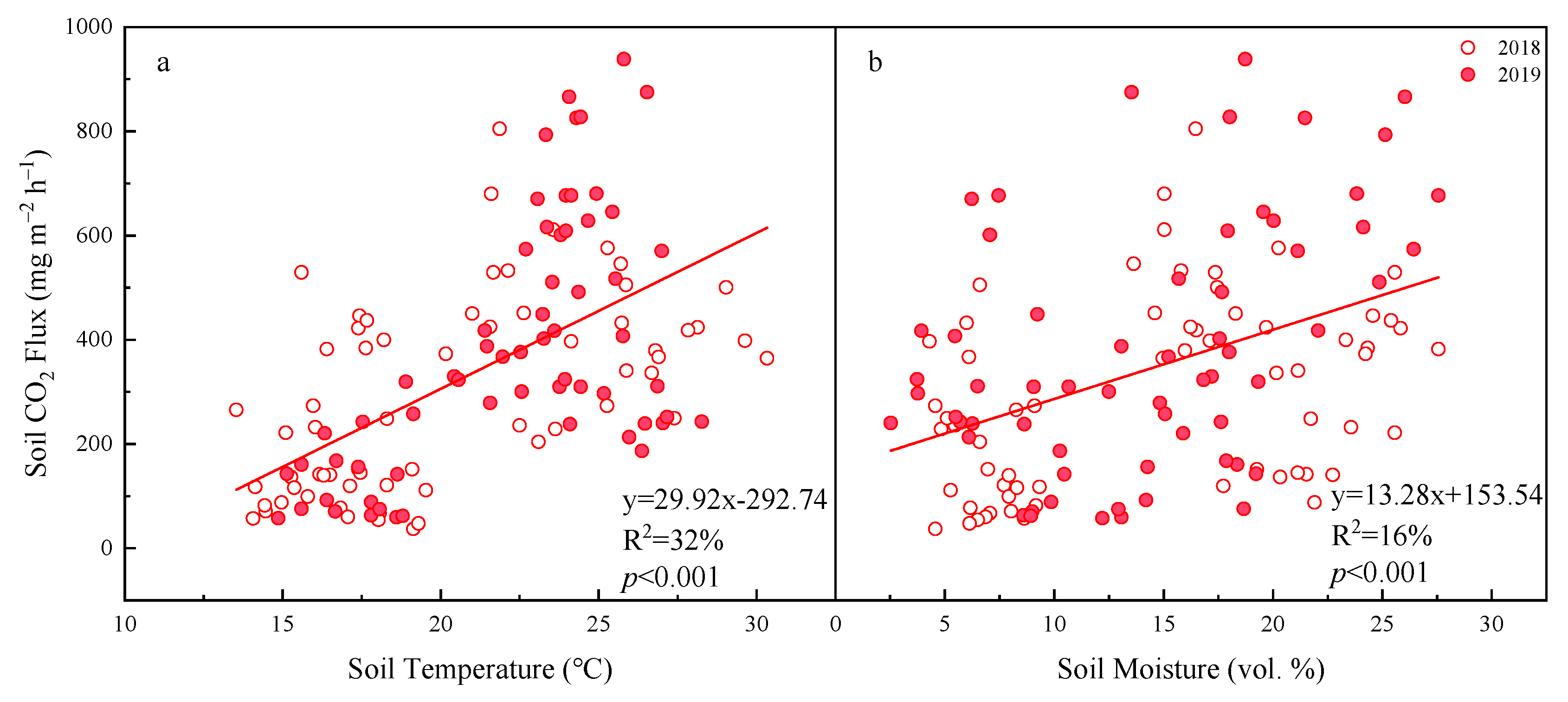
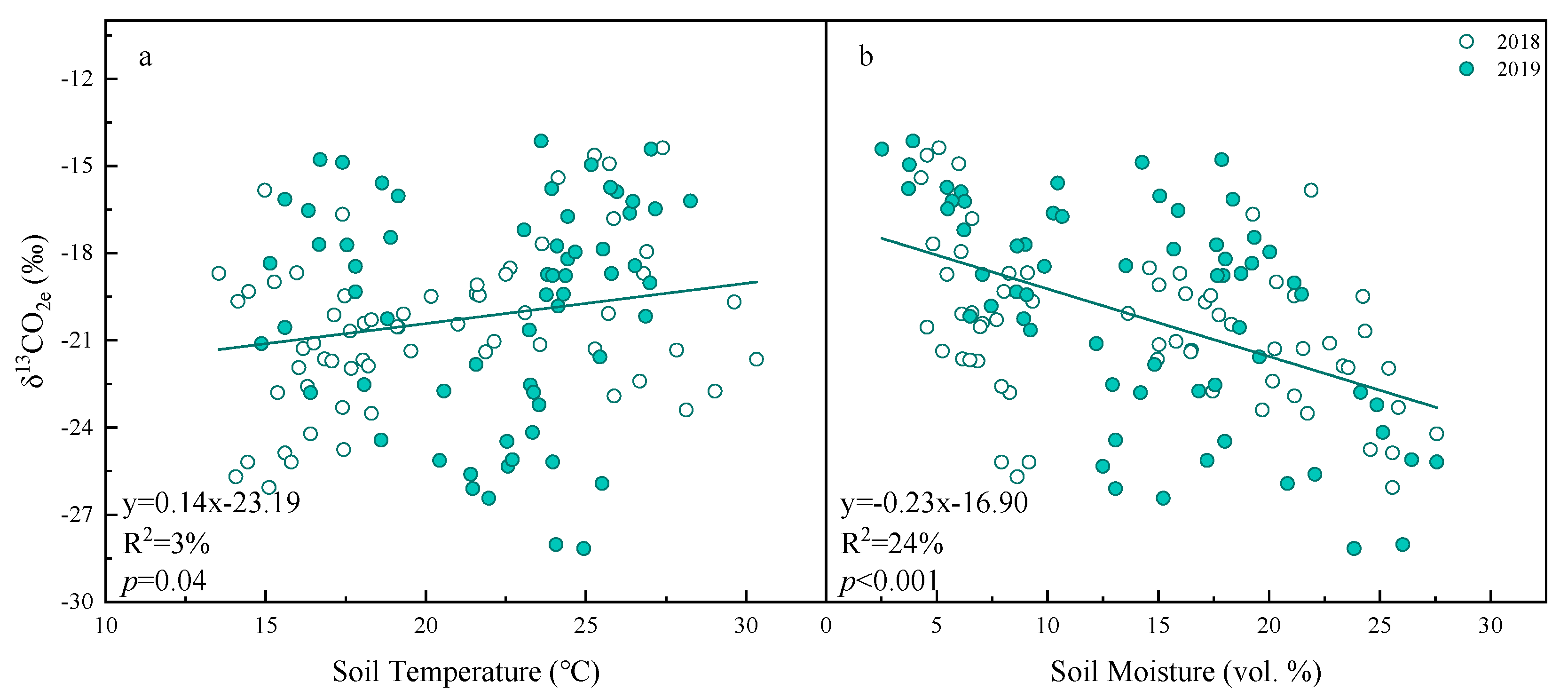
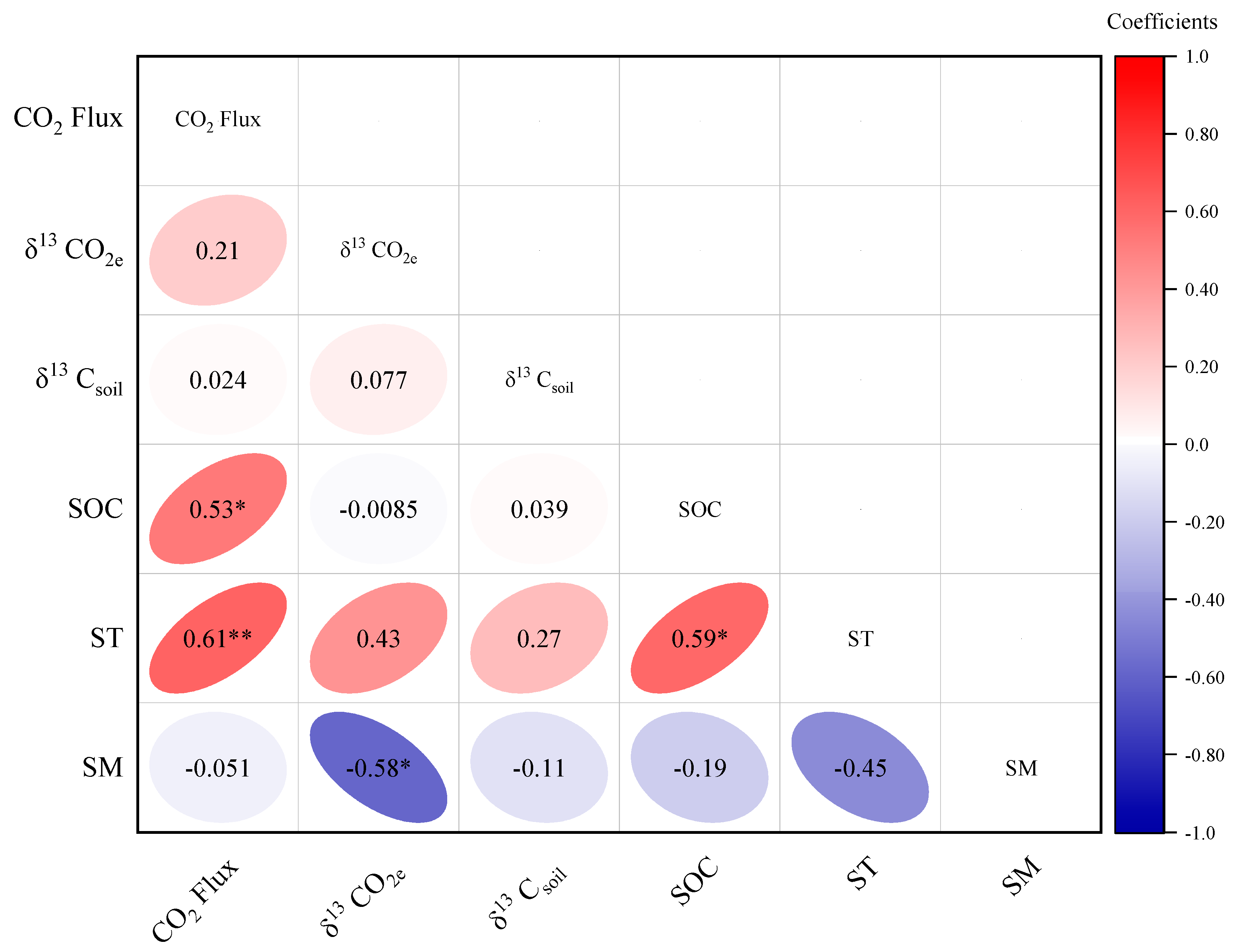
| Source | ST (°C) | SM (vol. %) | CO2 Flux (mg m−2·h−1) | δ13C-CO2 (‰) |
|---|---|---|---|---|
| Year (Y) | 139.3 *** | 0.02 | 85.9 *** | 11.4 *** |
| Date (D) | 336.5 *** | 232.7 *** | 187.8 *** | 64.3 *** |
| Warming (T) | 46.4 *** | 47.4 *** | 25.7 *** | 27.7 *** |
| Increased precipitation (W) | 11.2 *** | 37.9 *** | 11.4 *** | 6.3 ** |
| T × W | 1.9 | 0.6 | 1.9 | 1.1 |
| Y × D | 52.4 *** | 380.1 *** | 47.5 *** | 48.5 *** |
| Y × T | 1.0 | 14.1 *** | 0.5 | 12.9 *** |
| Y × W | 1.3 | 4.5 * | 3.0 | 0.7 |
| D × T | 0.8 | 3.2 ** | 4.1 *** | 3.6 *** |
| D × W | 0.6 | 0.6 | 0.9 | 1.5 |
| Y × D × T | 1.0 | 2.0 * | 1.3 | 2.5 ** |
| Y × D × W | 1.5 | 1.1 | 3.0 ** | 2.2 * |
| Y × T × W | 1.2 | 1.9 | 6.5 *** | 1.0 |
| D × T × W | 0.5 | 0.9 | 2.0 ** | 1.4 |
| Y × D × T × W | 0.7 | 1.4 | 2.3 ** | 1.5 |
| Items | Year | Treatments | T0 | T1 | T2 | Mean | S.E.M |
|---|---|---|---|---|---|---|---|
| ST (°C) | 2018 | W0 | 19.6 | 21 | 22.5 | 21 A | 0.6 |
| W1 | 18.9 | 20.1 | 21.2 | 20.1 B | 0.6 | ||
| W2 | 19 | 20.1 | 20.4 | 19.9 B | 0.6 | ||
| 2019 | W0 | 21.2 | 23.1 | 23.5 | 22.6 A | 0.5 | |
| W1 | 21.8 | 21.9 | 22.9 | 22.2 AB | 0.5 | ||
| W2 | 21.2 | 22 | 22.7 | 22 B | 0.5 | ||
| Total | Mean | 20.3 C | 21.4 B | 22.2 A | 21.3 | ||
| SM (vol. %) | 2018 | W0 | 14.5 | 13 | 13.4 | 13.6 C | 0.9 |
| W1 | 15 | 13.6 | 13.8 | 14.1 B | 0.9 | ||
| W2 | 15.8 | 15.4 | 15 | 15.4 A | 1.0 | ||
| 2019 | W0 | 15 | 11 | 12.1 | 12.7 B | 0.8 | |
| W1 | 16.2 | 13.6 | 14.5 | 14.8 A | 0.8 | ||
| W2 | 18.4 | 13.5 | 14.7 | 15.5 A | 1.0 | ||
| Total | Mean | 15.8 A | 13.4 C | 13.9B | 14.4 | ||
| CO2 flux (mg m−2·h−1) | 2018 | W0 | 244.4 | 251.9 | 281.2 | 259.17 B | 21.1 |
| W1 | 306.7 | 314.4 | 341.5 | 320.84 A | 26.9 | ||
| W2 | 214.2 | 290.3 | 413.8 | 306.1 A | 25.7 | ||
| 2019 | W0 | 302.6 | 327.7 | 451.7 | 360.7 B | 34.6 | |
| W1 | 314.1 | 430.5 | 412 | 385.55 B | 32.2 | ||
| W2 | 413.9 | 435.1 | 450.8 | 433.28 A | 35.0 | ||
| Total | Mean | 299.3 C | 341.7 B | 391.9 A | 344.3 | ||
| δ13CO2e (‰) | 2018 | W0 | −20.4 | −19.9 | −20.3 | −20.2 A | 0.4 |
| W1 | −21.9 | −19.7 | −19.8 | −20.4 AB | 0.4 | ||
| W2 | −22.5 | −20.3 | −20.6 | −21.1 B | 0.4 | ||
| 2019 | W0 | −19.7 | −18 | −20.3 | −19.4 A | 0.5 | |
| W1 | −20.3 | −18.6 | −21.4 | −20.1 B | 0.5 | ||
| W2 | −20.9 | −18.4 | −21.3 | −20.2 B | 0.5 | ||
| Total | Mean | −21 B | −19.2 A | −20.6 B | −20.2 |
| Items | Warming | Precipitation | 2018 | 2019 | Mean | S.E.M | p-Values | ||
|---|---|---|---|---|---|---|---|---|---|
| T | W | T × W | |||||||
| δ13Csoil (‰) | T0 | W0 | –25.11 | –22.52 | –23.46 c | 0.25 | *** | ns | * |
| W1 | –24.11 | –23.13 | |||||||
| W2 | –22.76 | –23.14 | |||||||
| T1 | W0 | –22.48 | –23.11 | –22.51 b | 0.24 | ||||
| W1 | –22.64 | –23.11 | |||||||
| W2 | –20.91 | –22.83 | |||||||
| T2 | W0 | –20.51 | –22.59 | –21.96 a | 0.24 | ||||
| W1 | –21.17 | –22.6 | |||||||
| W2 | –22.28 | –22.58 | |||||||
| Mean | –22.44 a | –22.85 b | |||||||
| SOC (g/kg) | T0 | W0 | 12.1 | 12.7 | 12.3 b | 0.32 | * | ns | ns |
| W1 | 11.2 | 13 | |||||||
| W2 | 13.2 | 11.6 | |||||||
| T1 | W0 | 12.5 | 14.3 | 13.1 ab | 0.40 | ||||
| W1 | 11.3 | 14.1 | |||||||
| W2 | 12.6 | 14 | |||||||
| T2 | W0 | 11.6 | 13.5 | 14.2 a | 0.82 | ||||
| W1 | 13.4 | 16.5 | |||||||
| W2 | 12.8 | 17.7 | |||||||
| Mean | 12.3 b | 14.1 a | |||||||
| Items | Precipitation | T0 | T1 | T2 | Mean | S.E.M | p-Values | ||
|---|---|---|---|---|---|---|---|---|---|
| T | W | T × W | |||||||
| Δe-s (‰) | W0 | 3.7 | 3.8 | 1.3 | 2.9 a | 0.4 | *** | * | ns |
| W1 | 2.6 | 3.7 | 1.3 | 2.5 b | 0.4 | ||||
| W2 | 1.2 | 2.5 | 1.5 | 1.7 c | 0.5 | ||||
| Mean | 2.5 a | 3.3 a | 1.3 b | 2.4 | |||||
Publisher’s Note: MDPI stays neutral with regard to jurisdictional claims in published maps and institutional affiliations. |
© 2022 by the authors. Licensee MDPI, Basel, Switzerland. This article is an open access article distributed under the terms and conditions of the Creative Commons Attribution (CC BY) license (https://creativecommons.org/licenses/by/4.0/).
Share and Cite
Guo, N.; Lv, S.; Lv, G.; Xu, X.; Yao, H.; Yu, Z.; Qiu, X.; Wang, Z.; Wang, C. Effects of Warming and Precipitation on Soil CO2 Flux and Its Stable Carbon Isotope Composition in the Temperate Desert Steppe. Sustainability 2022, 14, 3351. https://doi.org/10.3390/su14063351
Guo N, Lv S, Lv G, Xu X, Yao H, Yu Z, Qiu X, Wang Z, Wang C. Effects of Warming and Precipitation on Soil CO2 Flux and Its Stable Carbon Isotope Composition in the Temperate Desert Steppe. Sustainability. 2022; 14(6):3351. https://doi.org/10.3390/su14063351
Chicago/Turabian StyleGuo, Na, Shijie Lv, Guangyi Lv, Xuebao Xu, Hongyun Yao, Zhihui Yu, Xiao Qiu, Zhanyi Wang, and Chengjie Wang. 2022. "Effects of Warming and Precipitation on Soil CO2 Flux and Its Stable Carbon Isotope Composition in the Temperate Desert Steppe" Sustainability 14, no. 6: 3351. https://doi.org/10.3390/su14063351
APA StyleGuo, N., Lv, S., Lv, G., Xu, X., Yao, H., Yu, Z., Qiu, X., Wang, Z., & Wang, C. (2022). Effects of Warming and Precipitation on Soil CO2 Flux and Its Stable Carbon Isotope Composition in the Temperate Desert Steppe. Sustainability, 14(6), 3351. https://doi.org/10.3390/su14063351








